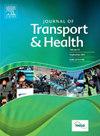Severity of bicycle non-vehicle crashes in Hong Kong: A comparative study of non-collision and collision injuries
IF 3.2
3区 工程技术
Q2 PUBLIC, ENVIRONMENTAL & OCCUPATIONAL HEALTH
引用次数: 0
Abstract
Introduction
With limited road space and a highly developed public transport system, Hong Kong has low bicycle usage and bicycles are primarily regarded as recreational tools. Consequently, cyclist safety concerns and road crashes have received relatively little attention.
Methods
To address this gap, this study conducts a comparative analysis of non-collision and collision injury severity in bicycle non-vehicle (BNV) crashes, using a total of 17,490 cyclist injury records in Hong Kong (2014–2023). Random parameters logit models are employed to evaluate the impact of key factors on BNV crash outcomes.
Results
The findings demonstrate a downward trend in both non-collision and collision injury severity over the ten-year period. Factors significantly associated with more severe non-collision injuries include: cyclists aged 55 or above, maneuver of making turn, bicycles aged 5 years or less, road segments, Hong Kong Island, autumn season, dark conditions, and two-way roads and dual or more carriageways. For collision injuries, key risk factors include: cyclists aged 35 or above, male cyclists, collision with objects, maneuver of overtaking, bicycles aged 5 years or less, hit-and-run behaviors, road segments, during midnight to dawn, wet road surfaces, and dual or more carriageways.
Conclusions
The study underscores the need for dedicated cycle tracks and shared road designs to mitigate cyclist safety risks. These findings provide evidence-based recommendations for infrastructure improvements and policy interventions.
香港自行车非车辆碰撞严重程度:非碰撞与碰撞伤害比较研究
香港道路空间有限,而公共交通系统高度发达,单车使用率低,单车主要被视为康乐工具。因此,骑车人的安全问题和道路交通事故受到的关注相对较少。方法为了解决这一差距,本研究使用香港2014-2023年共17490份骑自行车者受伤记录,对自行车非车辆碰撞(BNV)的非碰撞和碰撞损伤严重程度进行了比较分析。采用随机参数logit模型评价关键因素对BNV碰撞结果的影响。结果10年间,非碰撞损伤和碰撞损伤的严重程度均呈下降趋势。与较严重非碰撞伤害有显著关联的因素包括:55岁或以上骑单车者、转弯操作、单车龄5年或以下、路段、香港岛、秋季、黑暗情况、双向道路及双车道或多车道。对于碰撞伤害,主要危险因素包括:35岁或以上的骑自行车者、男性骑自行车者、与物体碰撞、超车机动、5年或以下的自行车、肇事逃逸行为、道路路段、午夜至黎明期间、潮湿的路面以及双车道或多车道。该研究强调了专用自行车道和共享道路设计的必要性,以减轻骑自行车者的安全风险。这些发现为基础设施改善和政策干预提供了基于证据的建议。
本文章由计算机程序翻译,如有差异,请以英文原文为准。
求助全文
约1分钟内获得全文
求助全文

 求助内容:
求助内容: 应助结果提醒方式:
应助结果提醒方式:


